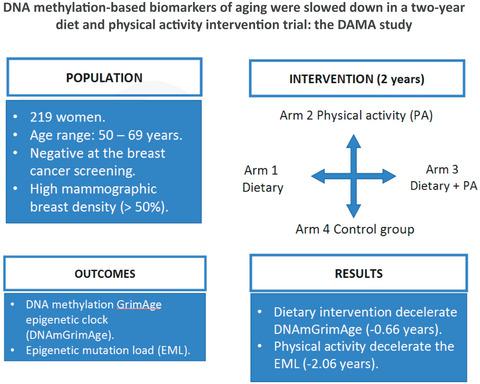当前位置:
X-MOL 学术
›
Aging Cell
›
论文详情
Our official English website, www.x-mol.net, welcomes your
feedback! (Note: you will need to create a separate account there.)
DNA methylation-based biomarkers of aging were slowed down in a two-year diet and physical activity intervention trial: the DAMA study
Aging Cell ( IF 8.0 ) Pub Date : 2021-09-18 , DOI: 10.1111/acel.13439 Giovanni Fiorito 1, 2 , Saverio Caini 3 , Domenico Palli 3 , Benedetta Bendinelli 3 , Calogero Saieva 3 , Ilaria Ermini 3 , Virginia Valentini 4 , Melania Assedi 3 , Piera Rizzolo 4 , Daniela Ambrogetti 3 , Laura Ottini 4 , Giovanna Masala 3
Aging Cell ( IF 8.0 ) Pub Date : 2021-09-18 , DOI: 10.1111/acel.13439 Giovanni Fiorito 1, 2 , Saverio Caini 3 , Domenico Palli 3 , Benedetta Bendinelli 3 , Calogero Saieva 3 , Ilaria Ermini 3 , Virginia Valentini 4 , Melania Assedi 3 , Piera Rizzolo 4 , Daniela Ambrogetti 3 , Laura Ottini 4 , Giovanna Masala 3
Affiliation

|
Several biomarkers of healthy aging have been proposed in recent years, including the epigenetic clocks, based on DNA methylation (DNAm) measures, which are getting increasingly accurate in predicting the individual biological age. The recently developed “next-generation clock” DNAmGrimAge outperforms “first-generation clocks” in predicting longevity and the onset of many age-related pathological conditions and diseases. Additionally, the total number of stochastic epigenetic mutations (SEMs), also known as the epigenetic mutation load (EML), has been proposed as a complementary DNAm-based biomarker of healthy aging. A fundamental biological property of epigenetic, and in particular DNAm modifications, is the potential reversibility of the effect, raising questions about the possible slowdown of epigenetic aging by modifying one's lifestyle. Here, we investigated whether improved dietary habits and increased physical activity have favorable effects on aging biomarkers in healthy postmenopausal women. The study sample consists of 219 women from the “Diet, Physical Activity, and Mammography” (DAMA) study: a 24-month randomized factorial intervention trial with DNAm measured twice, at baseline and the end of the trial. Women who participated in the dietary intervention had a significant slowing of the DNAmGrimAge clock, whereas increasing physical activity led to a significant reduction of SEMs in crucial cancer-related pathways. Our study provides strong evidence of a causal association between lifestyle modification and slowing down of DNAm aging biomarkers. This randomized trial elucidates the causal relationship between lifestyle and healthy aging-related epigenetic mechanisms.
中文翻译:

在为期两年的饮食和身体活动干预试验中,基于 DNA 甲基化的衰老生物标志物减慢了:DAMA 研究
近年来已经提出了几种健康衰老的生物标志物,包括基于 DNA 甲基化 (DNAm) 测量的表观遗传时钟,这些生物标志在预测个体生物学年龄方面变得越来越准确。最近开发的“下一代时钟”DNAmGrimAge 在预测寿命和许多与年龄相关的病理状况和疾病的发病方面优于“第一代时钟”。此外,随机表观遗传突变 (SEM) 的总数,也称为表观遗传突变负荷 (EML),已被提议作为基于 DNAm 的补充健康衰老生物标志物。表观遗传的一个基本生物学特性,特别是 DNAm 修饰,是这种效应的潜在可逆性,这引发了关于通过改变一个人的生活方式可能减缓表观遗传衰老的问题。在这里,我们调查了改善饮食习惯和增加体力活动是否对健康绝经后女性的衰老生物标志物产生有利影响。研究样本由来自“饮食、体力活动和乳房 X 线摄影”(DAMA)研究的 219 名女性组成:这是一项为期 24 个月的随机因子干预试验,在基线和试验结束时测量了两次 DNAm。参与饮食干预的女性 DNAmGrimAge 时钟显着减慢,而增加身体活动导致关键癌症相关途径中的 SEM 显着减少。我们的研究提供了强有力的证据,证明生活方式改变与 DNAm 衰老生物标志物减缓之间存在因果关系。这项随机试验阐明了生活方式与健康衰老相关的表观遗传机制之间的因果关系。我们调查了改善饮食习惯和增加身体活动是否对健康绝经后女性的衰老生物标志物产生有利影响。研究样本由来自“饮食、体力活动和乳房 X 线摄影”(DAMA)研究的 219 名女性组成:这是一项为期 24 个月的随机因子干预试验,在基线和试验结束时测量了两次 DNAm。参与饮食干预的女性 DNAmGrimAge 时钟显着减慢,而增加身体活动导致关键癌症相关途径中的 SEM 显着减少。我们的研究提供了强有力的证据,证明生活方式改变与 DNAm 衰老生物标志物减缓之间存在因果关系。这项随机试验阐明了生活方式与健康衰老相关的表观遗传机制之间的因果关系。我们调查了改善饮食习惯和增加身体活动是否对健康绝经后女性的衰老生物标志物产生有利影响。研究样本由来自“饮食、体力活动和乳房 X 线摄影”(DAMA)研究的 219 名女性组成:这是一项为期 24 个月的随机因子干预试验,在基线和试验结束时测量了两次 DNAm。参与饮食干预的女性 DNAmGrimAge 时钟显着减慢,而增加身体活动导致关键癌症相关途径中的 SEM 显着减少。我们的研究提供了强有力的证据,证明生活方式改变与 DNAm 衰老生物标志物减缓之间存在因果关系。这项随机试验阐明了生活方式与健康衰老相关的表观遗传机制之间的因果关系。
更新日期:2021-10-17
中文翻译:

在为期两年的饮食和身体活动干预试验中,基于 DNA 甲基化的衰老生物标志物减慢了:DAMA 研究
近年来已经提出了几种健康衰老的生物标志物,包括基于 DNA 甲基化 (DNAm) 测量的表观遗传时钟,这些生物标志在预测个体生物学年龄方面变得越来越准确。最近开发的“下一代时钟”DNAmGrimAge 在预测寿命和许多与年龄相关的病理状况和疾病的发病方面优于“第一代时钟”。此外,随机表观遗传突变 (SEM) 的总数,也称为表观遗传突变负荷 (EML),已被提议作为基于 DNAm 的补充健康衰老生物标志物。表观遗传的一个基本生物学特性,特别是 DNAm 修饰,是这种效应的潜在可逆性,这引发了关于通过改变一个人的生活方式可能减缓表观遗传衰老的问题。在这里,我们调查了改善饮食习惯和增加体力活动是否对健康绝经后女性的衰老生物标志物产生有利影响。研究样本由来自“饮食、体力活动和乳房 X 线摄影”(DAMA)研究的 219 名女性组成:这是一项为期 24 个月的随机因子干预试验,在基线和试验结束时测量了两次 DNAm。参与饮食干预的女性 DNAmGrimAge 时钟显着减慢,而增加身体活动导致关键癌症相关途径中的 SEM 显着减少。我们的研究提供了强有力的证据,证明生活方式改变与 DNAm 衰老生物标志物减缓之间存在因果关系。这项随机试验阐明了生活方式与健康衰老相关的表观遗传机制之间的因果关系。我们调查了改善饮食习惯和增加身体活动是否对健康绝经后女性的衰老生物标志物产生有利影响。研究样本由来自“饮食、体力活动和乳房 X 线摄影”(DAMA)研究的 219 名女性组成:这是一项为期 24 个月的随机因子干预试验,在基线和试验结束时测量了两次 DNAm。参与饮食干预的女性 DNAmGrimAge 时钟显着减慢,而增加身体活动导致关键癌症相关途径中的 SEM 显着减少。我们的研究提供了强有力的证据,证明生活方式改变与 DNAm 衰老生物标志物减缓之间存在因果关系。这项随机试验阐明了生活方式与健康衰老相关的表观遗传机制之间的因果关系。我们调查了改善饮食习惯和增加身体活动是否对健康绝经后女性的衰老生物标志物产生有利影响。研究样本由来自“饮食、体力活动和乳房 X 线摄影”(DAMA)研究的 219 名女性组成:这是一项为期 24 个月的随机因子干预试验,在基线和试验结束时测量了两次 DNAm。参与饮食干预的女性 DNAmGrimAge 时钟显着减慢,而增加身体活动导致关键癌症相关途径中的 SEM 显着减少。我们的研究提供了强有力的证据,证明生活方式改变与 DNAm 衰老生物标志物减缓之间存在因果关系。这项随机试验阐明了生活方式与健康衰老相关的表观遗传机制之间的因果关系。











































 京公网安备 11010802027423号
京公网安备 11010802027423号